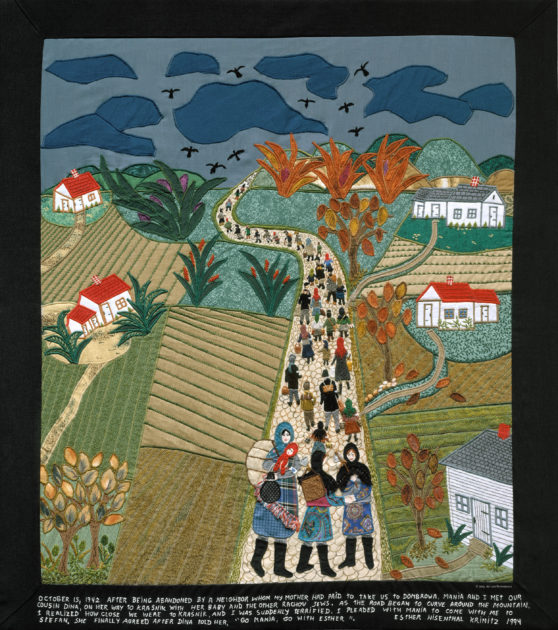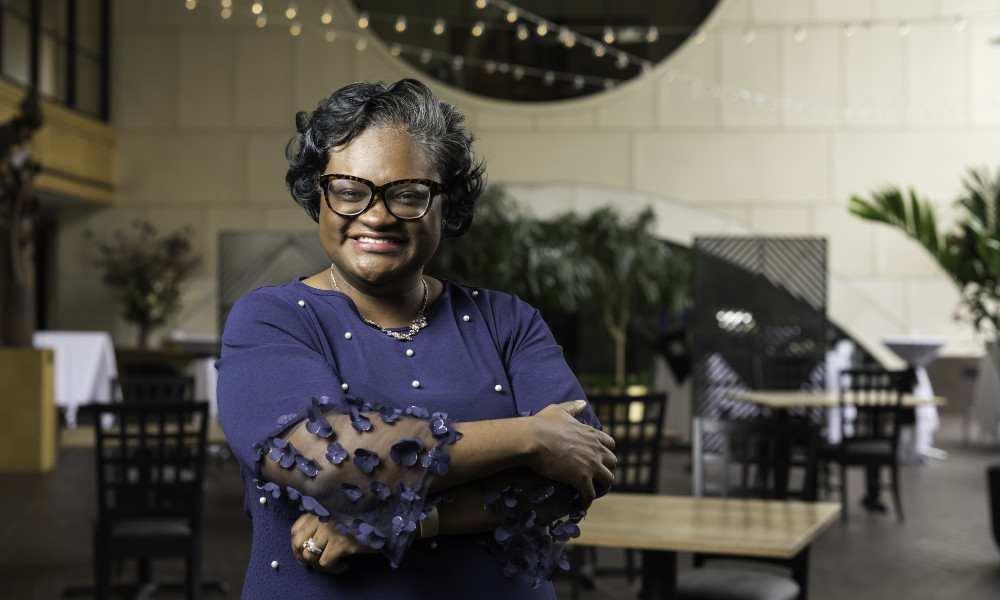Memorial Art Gallery exhibition showcases Holocaust survivor’s intricate fabric panels.
The intricate needlework and fabric panels Esther Nisenthal Krinitz created for her two daughters, simply to record her memories, are the subject of a Memorial Art Gallery exhibit evoking both beauty and tragedy in rich detail.
Fabric of Survival: The Art of Esther Nisenthal Krinitz, on view through December 2, chronicles the artist’s bucolic childhood in Poland and subsequent decision—at 15—to go off on her own, with her younger sister, rather than stay with her family and neighbors who were forced on a journey to a death camp during the Holocaust.
The 36 panels on exhibit are relevant in today’s world, says Marlene Hamann-Whitmore, the museum’s McPherson Director of Academic Programs.
“It can be too easy to forget—or never learn—our collective history, and it’s so important for our collective memory to keep it alive,” says Hamann-Whitmore. “These atrocities are still happening, and sometimes art allows us to have conversations that are difficult otherwise.”
Though Krinitz, who died in 2001, had no formal art education, she was trained as a seamstress, which made textiles a natural conduit for her poignant story.

Jonathan Binstock, the Mary W. and Donald R. Clark Director at MAG, says Krinitz could be labeled an “outsider” or “untutored artist,” but her work “is of an extraordinary quality and deserving of a place in an art museum exhibition program.”
Home to more than 600 textiles in its permanent collection, the museum routinely presents and collects textile works of art.
“Some people have something incredible inside them that they are able to convey visually, in material form,” says Binstock. “Krinitz was one of these people.”
Over the years, Krinitz filled notebooks with stories about what had happened to her, but she was 50 before she created her first panel—an image of herself as a girl in the picturesque village of Mniszek, carrying water from the river up a hill toward her house and family. Her second panel, made a year later, showed her swimming with her older brother in that same river, while three of her sisters tend geese nearby.
Krinitz produced the rest while in her 60s, the images detailing what followed: the Gestapo terrorizing her family; she and her sister fleeing across fields; soldiers leaving her alone only after being swarmed by bees.
“Despite the pain that she experienced in reliving these memories so slowly, so carefully as she stitched them, it was important for her to be able to take them out of her mind and onto fabric,” says her eldest daughter, Bernice Steinhardt.
“I cannot recall a time when I did not know my mother’s stories,” she says, “but during the roughly 10 years she spent creating most of these pictures, she talked about her memories even more than she had before. I think she was trying to keep them from disappearing.”
Each image includes meticulous hand-embroidered captions.
The caption for the panel Ordered to Leave Our Homes: “This was my family on the morning of October 15, 1942. We were ordered by the Gestapo to leave our homes by 10 a.m. to join all the other Jews on the road to Krasnik railroad station and then to their deaths.”
Recalls Steinhardt: “She always said that was the most difficult picture for her to do—not technically, but emotionally.”
Krinitz’s story inspired a 30-minute award-winning documentary, Through the Eye of the Needle, which examines her life and work.
The first two panels that Krinitz made, hanging outside the exhibition entrance, are being used to help elicit positive memories for people with Alzheimer’s disease and dementia who visit to the museum every week as part of a partnership between the museum and the Rochester chapter of the Alzheimer’s Association.
The panels also are helping to spark conversations with younger visitors, and there are plans to bring in refugees as well.
“Maybe this will encourage other people to tell their stories,” says Hamann-Whitmore.
Fabric of Survival is on view through December 2.
—Robin L. Flanigan



